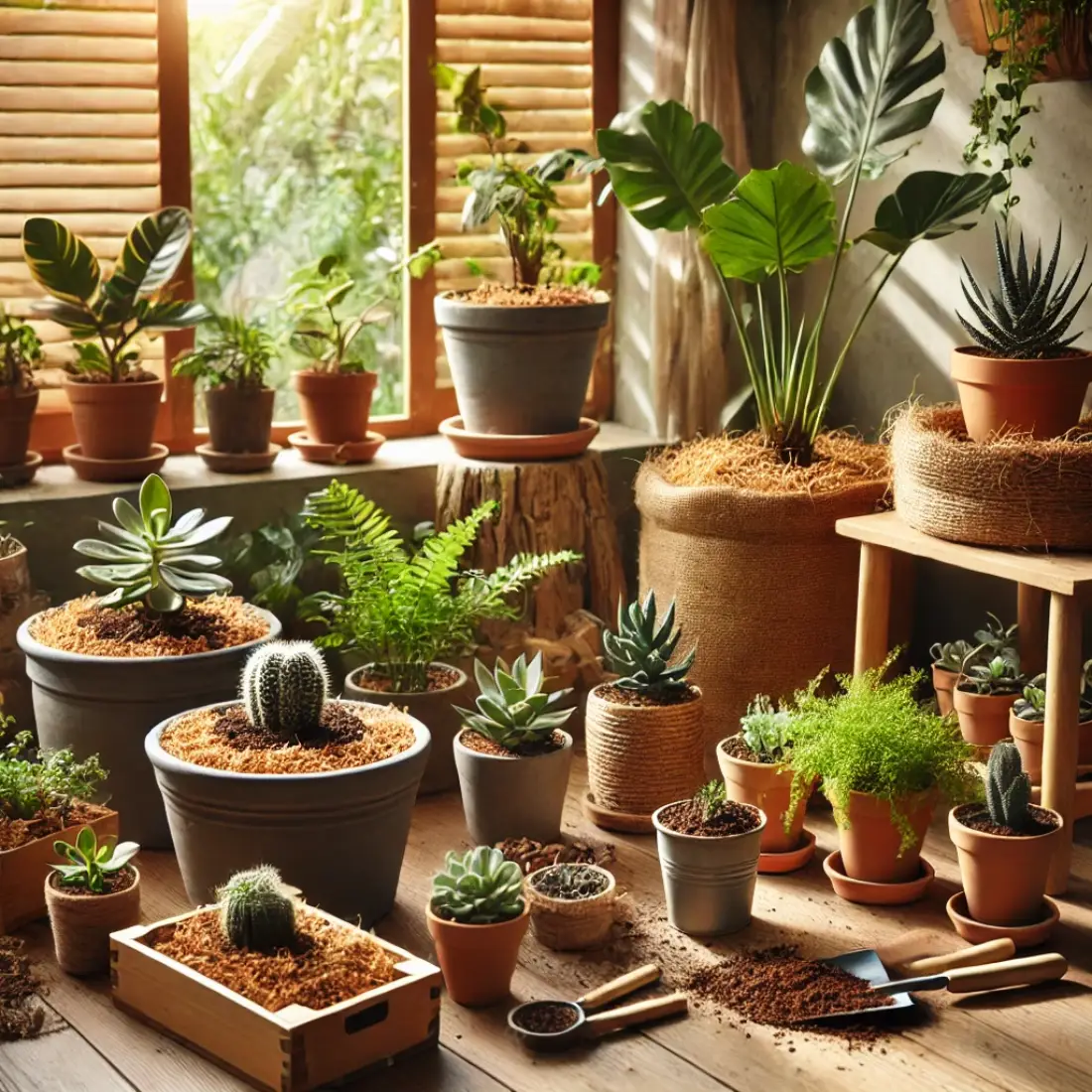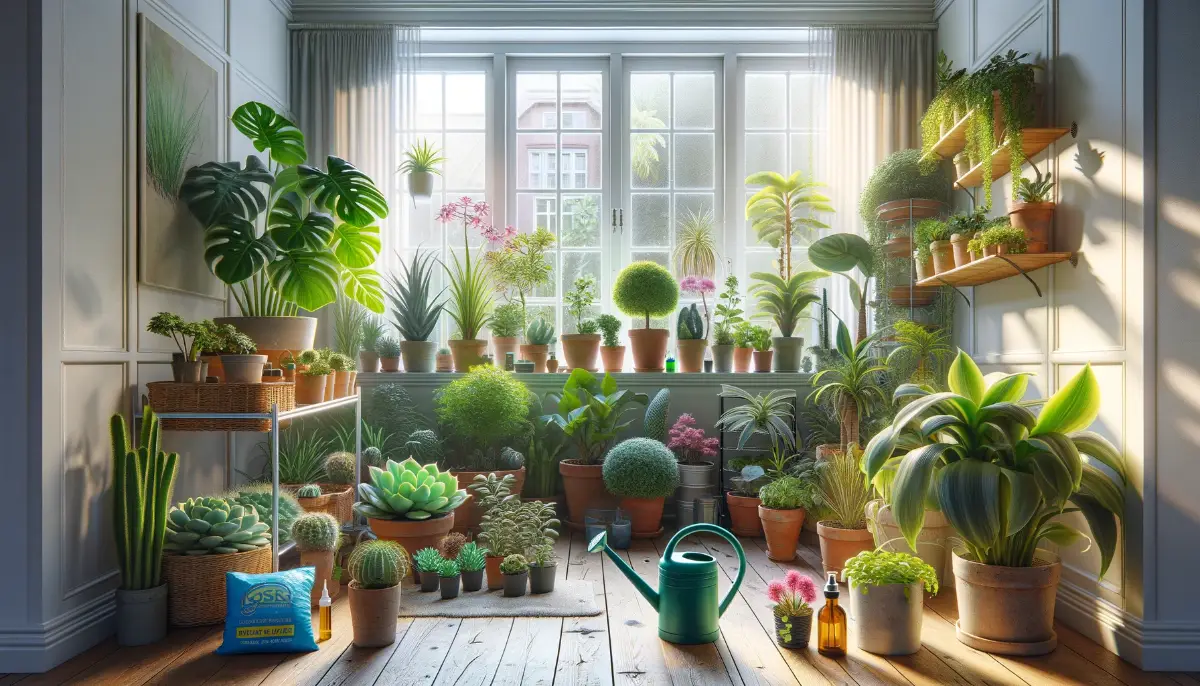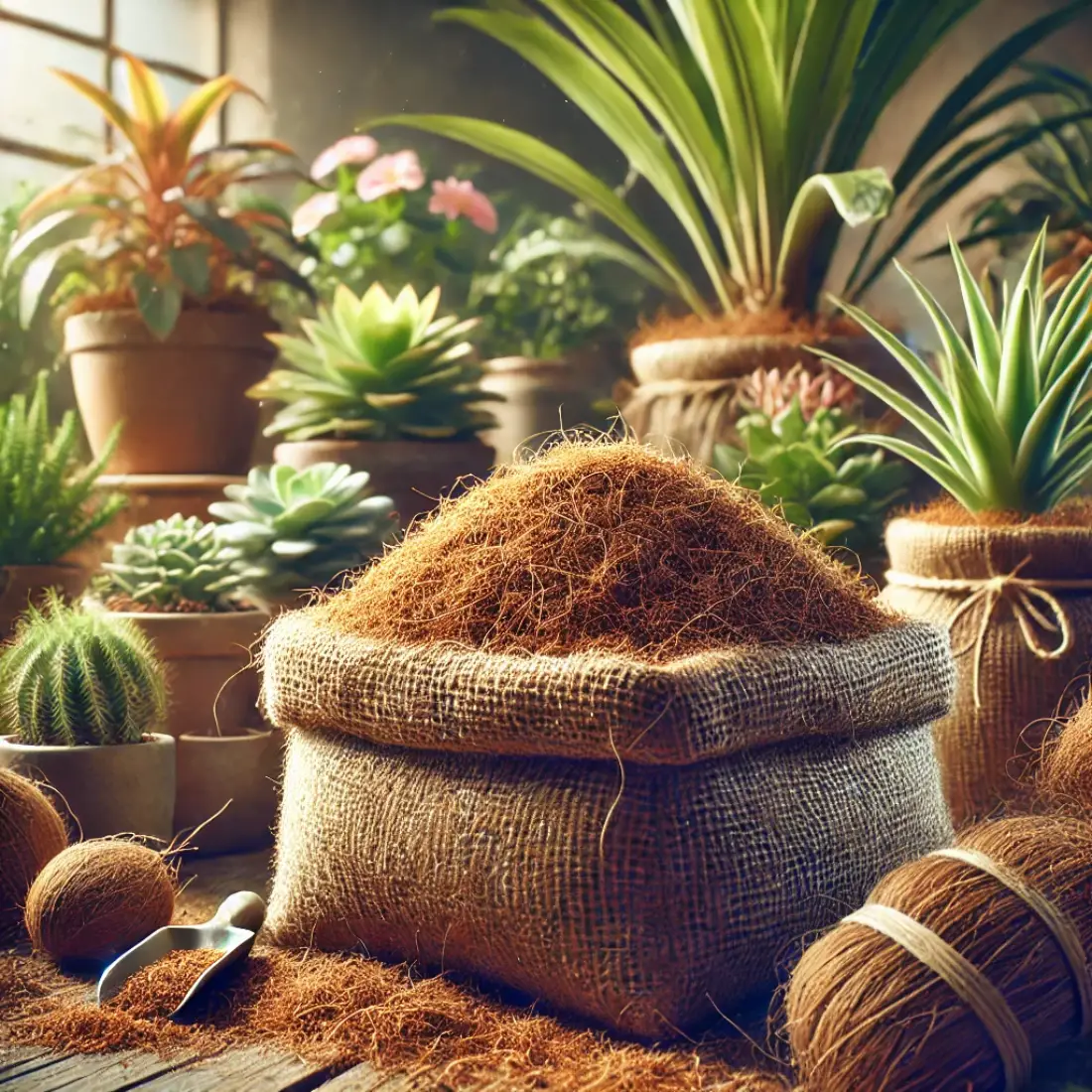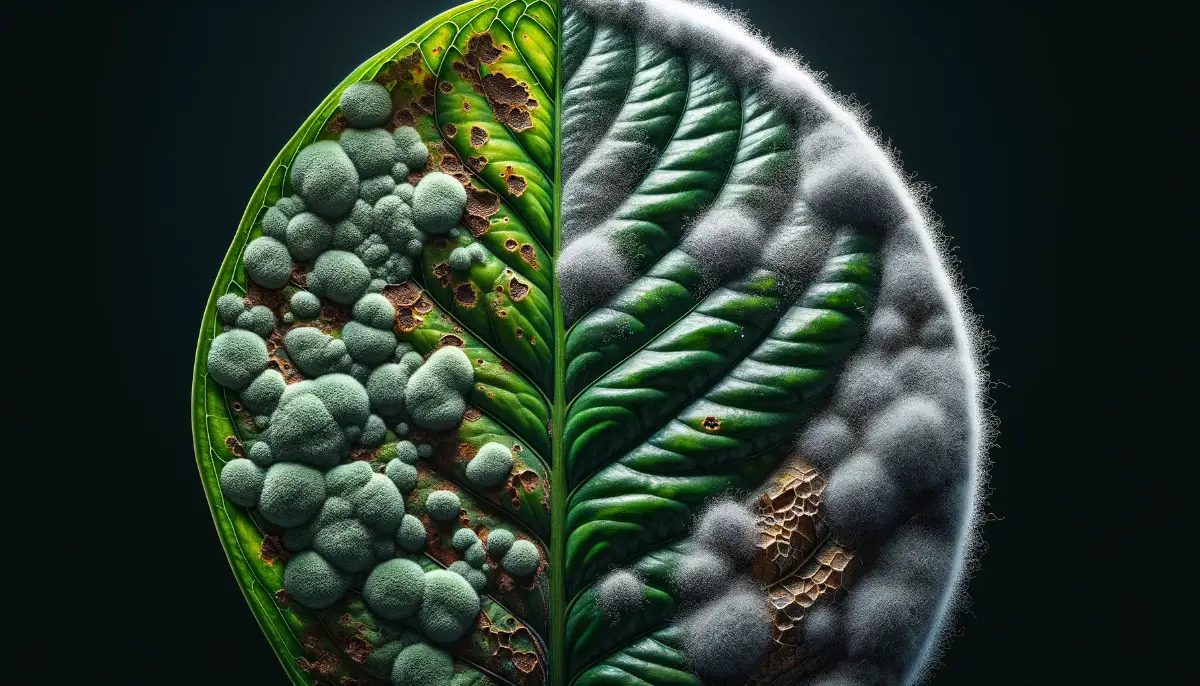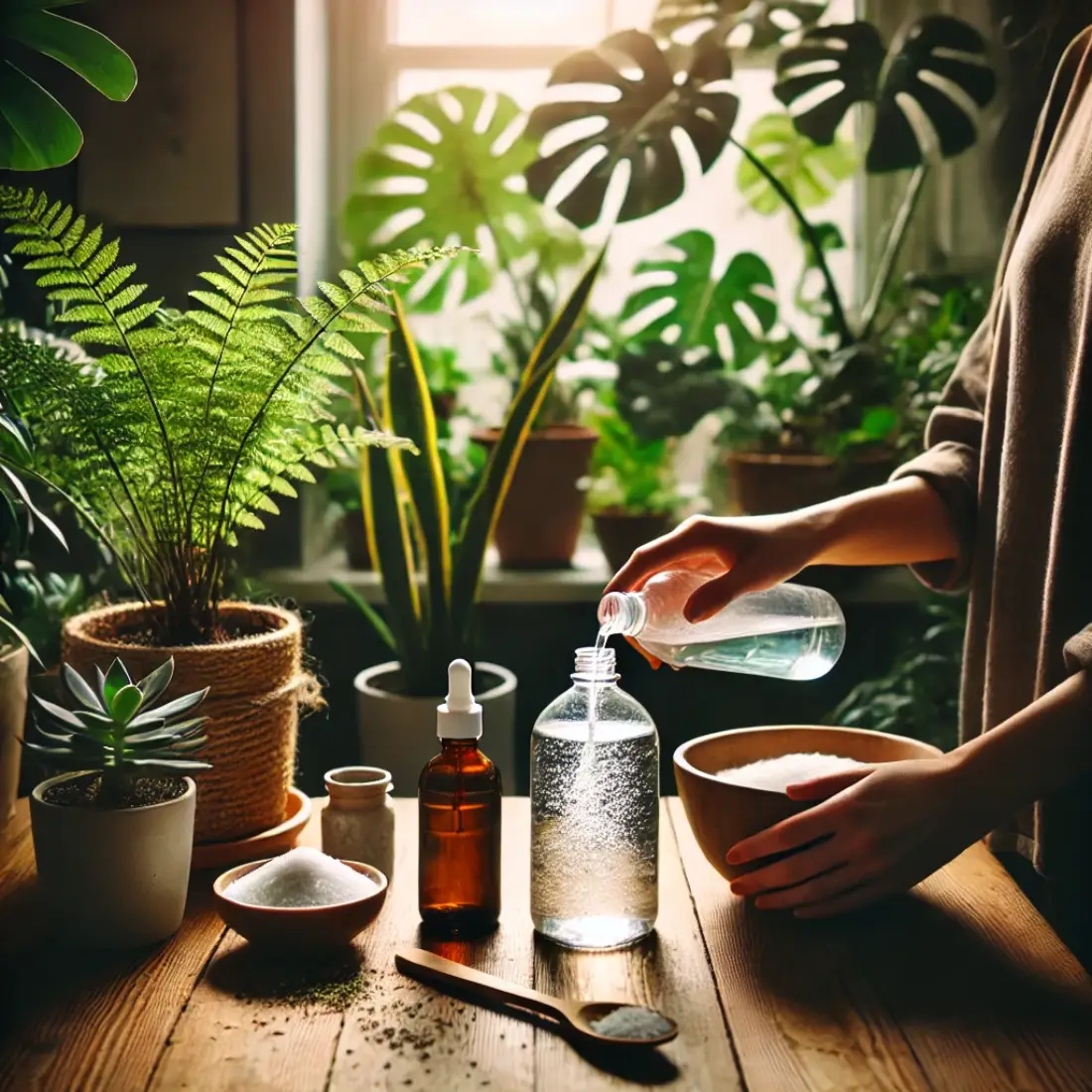Organic mulching is a simple yet powerful technique for keeping indoor plants healthy and thriving. By using natural materials like coconut coir, compost, or wood chips, you can create a protective layer that helps retain moisture, regulate soil temperature, and improve overall plant health. Indoor plants often face challenges like inconsistent watering and dry air, but with the right organic mulch, these issues can be easily managed.
- Organic mulching helps retain moisture and regulate soil temperature for indoor plants.
- Different types of organic mulch offer unique benefits for plant health and growth.
- Mulching supports natural decomposition and nutrient cycles in indoor gardens.
- Eco-friendly mulch options reduce waste and promote sustainable gardening practices.
Why Indoor Plants Need Mulch?
Indoor plants benefit from organic mulch in many ways, just like outdoor plants. Mulch helps maintain consistent soil moisture by slowing down evaporation, which is especially important for indoor environments where heating or air conditioning can dry out the air. It creates a protective barrier, preventing the soil from becoming compacted or eroding after watering.
Mulching also regulates soil temperature, keeping it cooler during hot days and warmer during colder months, creating a stable environment for roots to grow. For indoor plants in smaller pots, the soil can dry out or fluctuate in temperature faster than in a garden. A layer of organic mulch solves these issues by offering insulation and preventing quick moisture loss.
Additionally, as organic mulch breaks down, it releases valuable nutrients into the soil, promoting healthier plant growth. This natural decomposition supports beneficial bacteria and earthworms, improving soil health. Mulch also helps reduce the risk of fungal growth and mold by keeping water off the plant’s leaves and stems, especially in humid indoor spaces.
Overall, mulching helps create a healthier, more balanced environment for indoor plants, reducing the need for frequent watering and providing a slow, natural source of nutrients.
Top 5 Organic Mulching Techniques for Indoor Plants
Coconut Coir Mulch
Coconut coir mulch is a sustainable and effective organic mulching option for indoor plants. Made from the fibrous husks of coconuts, this mulch is highly absorbent, which makes it excellent for retaining moisture in potted plants. It helps prevent soil compaction, allowing air to circulate better around the plant roots while ensuring the soil stays moist for longer periods.
One of the key benefits of coconut coir mulch is its slow decomposition rate, meaning it lasts longer than many other organic mulches. As it breaks down, it enriches the soil with organic matter without altering the soil’s pH levels, making it ideal for most houseplants. Additionally, coir mulch is lightweight and easy to apply, making it perfect for indoor gardening.
Coconut coir is also eco-friendly, as it’s a byproduct of the coconut industry, reducing waste. Unlike some other mulching options, coir doesn’t attract pests, making it safer for indoor environments. Its natural structure also provides good drainage while retaining enough moisture to keep plants hydrated.
Compost Mulch
Compost mulch is one of the best organic mulching options for indoor plants, as it combines moisture retention with nutrient enrichment. Compost is made from decomposed organic materials such as kitchen scraps, leaves, and plant matter, creating a nutrient-rich substance that benefits plant growth. When used as mulch, it not only helps keep the soil moist by reducing evaporation but also adds essential nutrients like nitrogen, phosphorus, and potassium to the soil as it breaks down.
For indoor plants, compost mulch is especially useful because it provides a steady stream of nutrients, reducing the need for additional fertilizers. The compost also helps improve soil structure, making it more porous and enhancing root growth. This makes it an excellent choice for nutrient-hungry indoor plants such as tomatoes, herbs, or flowering species.
Additionally, compost mulch supports beneficial microorganisms and earthworms that aid in breaking down organic material and improving soil health. However, it’s essential to use fully decomposed compost to avoid unwanted odors or pest problems in an indoor setting.
Straw Mulch
Straw mulch is an excellent organic option for indoor plants, providing effective moisture retention and insulation. Made from the dried stalks of grain plants, straw is light and easy to apply, offering a simple yet effective way to protect your indoor plants’ soil. By placing a layer of straw on the soil, you help prevent water evaporation, keeping the soil consistently moist, which is especially important in dry indoor environments.
Straw mulch is also great at regulating soil temperature, acting as an insulator. This ensures the soil remains cool in warmer months and warm during colder periods, which can be beneficial for plants in fluctuating indoor conditions. Additionally, straw breaks down slowly, providing organic material to the soil over time. As it decomposes, it enriches the soil with nutrients, helping to improve its structure.
One advantage of straw mulch is its lightweight nature, making it ideal for potted plants, as it doesn’t weigh down the soil or compact it. It’s also a relatively inexpensive and widely available mulching option. However, make sure to use clean, seed-free straw to avoid introducing weeds into your indoor plants.
Wood Chips or Bark Mulch
Wood chips or bark mulch are popular organic mulching options for indoor plants, providing long-lasting protection and enhancing soil health. Made from tree bark or small wood pieces, these mulches offer excellent moisture retention and insulation. When placed on top of the soil, wood chips slow down evaporation, helping plants stay hydrated longer, which is particularly important in indoor environments with dry air.
Wood and bark mulch also help regulate soil temperature, keeping it cooler during hot months and warmer during colder seasons. This stable temperature is essential for indoor plants, as temperature fluctuations can stress roots. As the wood chips slowly decompose, they add valuable organic material to the soil, improving its structure and promoting healthy root growth. This slow breakdown makes them a low-maintenance mulching option since they don’t need frequent replacement.
However, one thing to consider is that certain types of wood, such as pine, can make the soil slightly acidic as they decompose. This can benefit acid-loving plants like ferns or orchids but may not be ideal for all plant types. Choosing hardwood or aged wood chips can mitigate this issue.
Leaf Mold Mulch
Leaf mold mulch is a fantastic, natural mulching option for indoor plants, made from decayed leaves. As leaves break down, they create a nutrient-rich, fluffy material that is excellent for moisture retention and soil improvement. When applied as mulch, leaf mold helps keep the soil evenly moist by reducing evaporation, which is vital for maintaining consistent hydration in indoor environments.
One of the main benefits of leaf mold mulch is its ability to improve soil structure. It helps lighten compacted soils, making it easier for plant roots to grow and absorb nutrients. This mulch also encourages the development of beneficial microorganisms and earthworms, which further enhance soil health and promote healthy plant growth.
Leaf mold is particularly effective at insulating plant roots, keeping them cool during warmer months and warm in colder conditions. It also decomposes slowly, releasing nutrients over time without overwhelming the plants. Unlike some other mulches, leaf mold is neutral in pH, making it suitable for most plant types without altering soil acidity.
Supporting Tips for Successful Mulching
Applying mulch properly to indoor plants is essential for maximizing its benefits. Here’s a simple step-by-step guide:
- Choose the right mulch: Pick an organic mulch like coconut coir, compost, straw, wood chips, or leaf mold. Ensure it’s suitable for your plant’s needs.
- Prepare the soil: Before adding mulch, water your plant thoroughly. Ensure the soil is moist but not soggy.
- Spread the mulch: Apply a 1 to 2-inch layer of mulch evenly on top of the soil, keeping it a few inches away from the plant’s stem to prevent rot or fungal growth.
- Maintain it: Check the mulch regularly. Fluff it occasionally to ensure it stays loose and doesn’t compact. Add more as it decomposes or thins out over time.
- Seasonal care: Adjust the thickness of the mulch depending on the season—use more in dry months and less during humid periods.
Common Mistakes to Avoid When Mulching Indoor Plants
When mulching indoor plants, it’s important to avoid common mistakes that can harm your plants rather than help them:
- Over-mulching: Applying too much mulch (more than 2 inches) can suffocate the roots and prevent proper airflow, leading to root rot or mold growth.
- Mulch too close to the stem: Piling mulch directly against the plant’s stem can cause stem rot. Always leave a gap of a few inches around the base of the plant.
- Using the wrong mulch: Some organic mulches, like fresh wood chips, can alter soil pH or tie up nitrogen as they decompose, which can harm sensitive indoor plants. Use aged wood chips or mulch suited for your plant’s needs.
- Ignoring decomposition: Organic mulch breaks down over time. Failing to replace or refresh the mulch can reduce its effectiveness in moisture retention and soil insulation.
By avoiding these mistakes, you’ll ensure your indoor plants get the full benefits of organic mulching.
FAQs on Organic Mulching for Indoor Plants
How often should I replace organic mulch for indoor plants?
Organic mulch should be replaced or replenished every 3 to 6 months, depending on how quickly it decomposes and how much moisture it retains.
Can I use any type of organic mulch for indoor plants?
No, certain mulches like fresh wood chips can alter soil pH. Stick to options like coconut coir, leaf mold, compost, or aged wood chips for the best results indoors.
Is it safe to use kitchen scraps as mulch for indoor plants?
Kitchen scraps should be fully composted before using them as mulch. Uncomposted scraps can attract pests or cause unpleasant odors indoors.
How thick should I apply mulch to indoor plants?
A layer of 1 to 2 inches is sufficient. Avoid over-mulching, as too thick a layer can block airflow and suffocate the plant’s roots.
Can mulch cause mold or pests in indoor plants?
If mulch is applied too thickly or not properly maintained, it can cause mold or attract pests. Keep mulch loose, dry, and refresh it as needed to avoid these issues.
What’s the best organic mulch for moisture retention?
Coconut coir and compost are excellent for moisture retention due to their absorbency. Both work well for indoor plants prone to drying out quickly.
Does mulch affect the plant’s growth rate?
Yes, organic mulch helps promote healthy growth by maintaining soil moisture, regulating temperature, and providing nutrients as it breaks down.
Can I use mulch for indoor succulents?
Yes, but use a light layer of mulch like small pebbles or coarse organic mulch to ensure proper airflow and avoid excess moisture around succulents.
Should I remove mulch before watering indoor plants?
No, mulch actually helps distribute water evenly. Watering through the mulch ensures slow, even absorption into the soil.
Can mulch be used in all seasons for indoor plants?
Yes, mulch helps year-round. In winter, it insulates roots, while in summer, it keeps the soil moist and cool.

